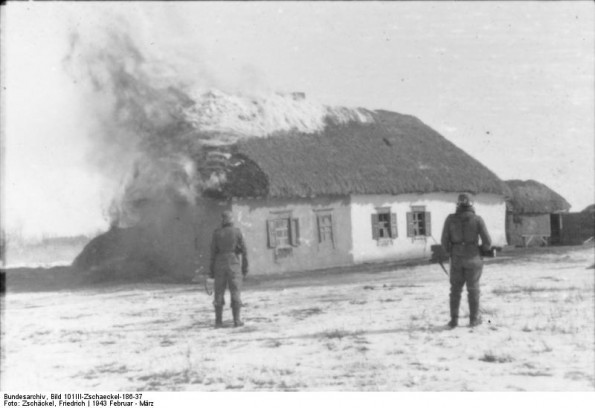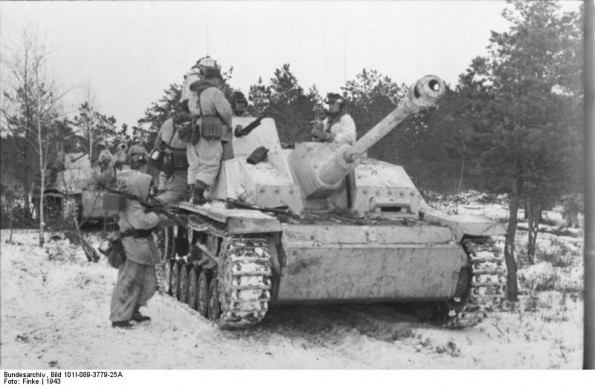Air Operations, Bismarcks
43rd Heavy Bomb Group B-17s attack Ubili.
[Air Operations, CBI
BURMA- 18 51st Fighter Group P-40s attack 2 towns in Burma.
Air Operations, Europe
BOMBER COMMANDEvening Ops:
- 377 aircraft are sent again to Lorient. In this total are 131 Lancasters, 103 Halifaxes, 99 Wellingtons and 44 Stirlings.
- 363 planes drop mainly incendiaries in almost clear visibility. This is the 8th raid in this area in response to direct instructions from the Air Ministry against Lorient. There are few available records from Lorient, but it is known that the town is almost completely destroyed and deserted.
- 1 Lancaster is lost.
- 32 aircraft lay mines off Brest and St Nazaire and there are 4 OTU sorties.
- There are no losses.
Air Operations, New Guinea
V Bomber Command B-25s the Malahang airfield at Lae and strafe targets of opportunity around Salamaua.
[Aleutian Islands
Japanese aircraft attack Amchitka Island, where the Americans have built a runway for their fighters.
[Eastern Front
After fierce fighting for several days, the Russian 40th and 3rd Tank Armies enter the suburbs of Kharkov when Hausser's II SS Pzr Corps are forced to withdraw despite an order from Hitler to hold on. The Germans fall back towards Poltava. Hitler equates the loss of Kharkov to Stalingrad and vows to retake Russia's 4th largest city. The Russians have now advanced 375 miles west of Stalingrad.
CENTRAL SECTORArmy Group Center informs OKH that it is unable to coordinate its actions with those of Army Group South and will therefore only be content with securing the positions of the 2nd Army.
SOUTHERN SECTORKharkov falls after a night of fierce fighting with the retreating SS Panzer Corps. The Soviet 69th Army's XV Tank Corps and 160th Rifle Div, 40th Army's 160th and 183rd Rifle Divs, V Tank Corps and units of the 3rd Tank Army have taken possession of the center of Kharkov. The 3rd Tank Army links up with the 40th Army in Dzerzhinsky Square then pushes south to attack the Germans west of Lyubotin. The 40th and 69th Armies begin a hurried redeployment northwest of Kharkov.
Hitler unfairly dismisses Lanz, replacing him with Kempf. Group Lanz, renamed Army Detachment Kempf, holds under its command SS Panzer Corps and Corps Raus. Zmiyef falls to the Soviet 6th Army.
|
|
Germany, Home Front
The Munich Students' 'Revolt'. Gauleiter Geisler of Bavaria harangues assembled university students and taunts them with insults and obscenities. The meeting ends in pandemonium as the students overpower SS guards and police and take to the streets. There is widespread outbreaks of sabotage, etc. in Munich and sympathetic student demonstrations occur in Vienna, Mannheim, Stuttgart, Frankfurt and the Ruhr.
[Guadalcanal
In preparation for the invasion of the Russell Islands, Operation CLEANSLATE, the first echelon of the 43rd Div assault force, the 103rd and 169th Regimental Combat Teams, under the command of Maj-Gen John H. Hester, CG of the 43rd Div, arrives at Guadalcanal.
[Indian Ocean
The US freighter Deer Lodge (6187t) is torpedoed by U-516 about 60 miles east of Port Elizabeth, South Africa. The 45 survivors abandon the ship in 3 lifeboats.
[North Africa
TUNISIAAxis forces push on towards Fériana and Sbeïtla, southwest and northeast of Kasserine. Some of Montgomery's forward units capture Medinine(17th?) on the approaches to the Mareth line where Rommel is established. The 'Mareth Line' was built by the French between 1934 and 1939, stretching from Djebel Dahar to the sea near Mareth itself, as a defense against a possible Italian attack from Tripolitania. The Mareth defensive line, the 'Desert Maginot' as it is rather pretentiously called, actually consists only of a few dozen pillboxes in the coastal area and some strong fortified positions in the mountainous zone.
The British 1st Army releases Combat Command B, US 1st Armored Div, to the US II Corps. The 18th Regimental Combat Team, US 1st Div, is released to the British V Corps for movement to Sbiba, where positions are being strengthened. In the US II Corps area, the Axis forces, anticipating the evacuation of Sbeïtla, which the 1st Armored Div is too weak to hold as a result of heavy losses at Sidi Bou Zid, begins a drive on the town late in the day. Despite the opposition of a screening force from the 1st Armored Div between Sidi Bou Zid and Sbeïtla, the Axis forces arrive at the outskirts of the latter and is briskly engaged by Combat Command A and Combat Command B, which has arrived from Maktar, as the withdrawal of the Americans toward Western Dorsal begins. Because of the unexpected sharp resistance, the enemy breaks off the attack for the night. The isolated Americans on Djebel Ksaïra and Garet Hadid, under attack throughout the day, make an unsuccessful attempt to withdraw during the night and are virtually wiped out. From Gafsa, the Germans advance 25 miles northwestward toward Fériana and southwestward through Metlaoui to Tozeur.
In the British 8th Army area, the 7th Armored Div drives into Ben Gardane, the Mareth Line outpost.
[Pacific
The US submarine Flying Fish (SS-229) sinks the Japanese stores ship Hyuga Maru (994t) 24 miles off Pagan, Marianas.
[Southwest Pacific
On the initiative of the Commander-in-Chief of the Southwest Pacific Area, the US 6th Army is created under the command of Lt-Gen Walter Krueger. It consistes of the I Corps under Gen Eichelberger, the 2nd Special Engineers Bde and the 503rd Parachute Infantry Regt. Attached to this formation of the army is the 1st Div of the US Marines.
[
